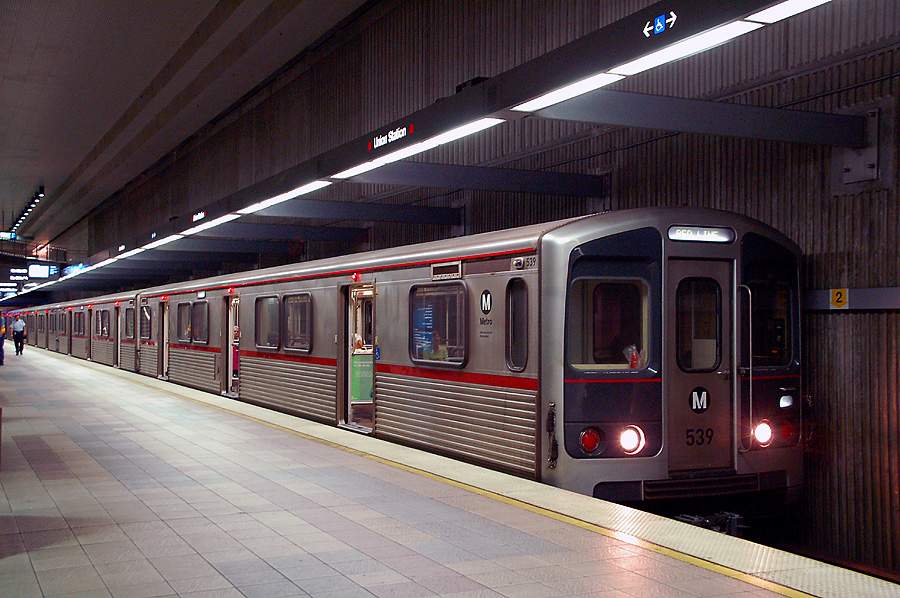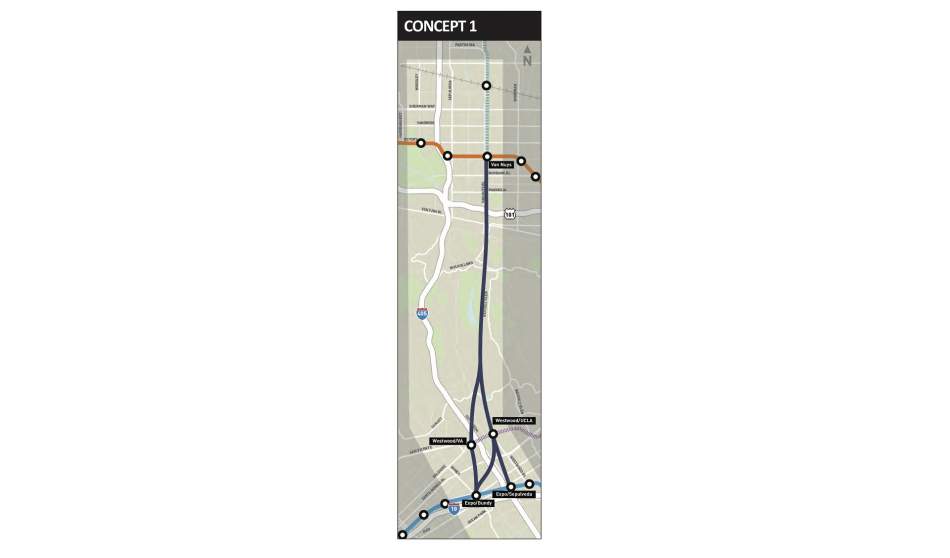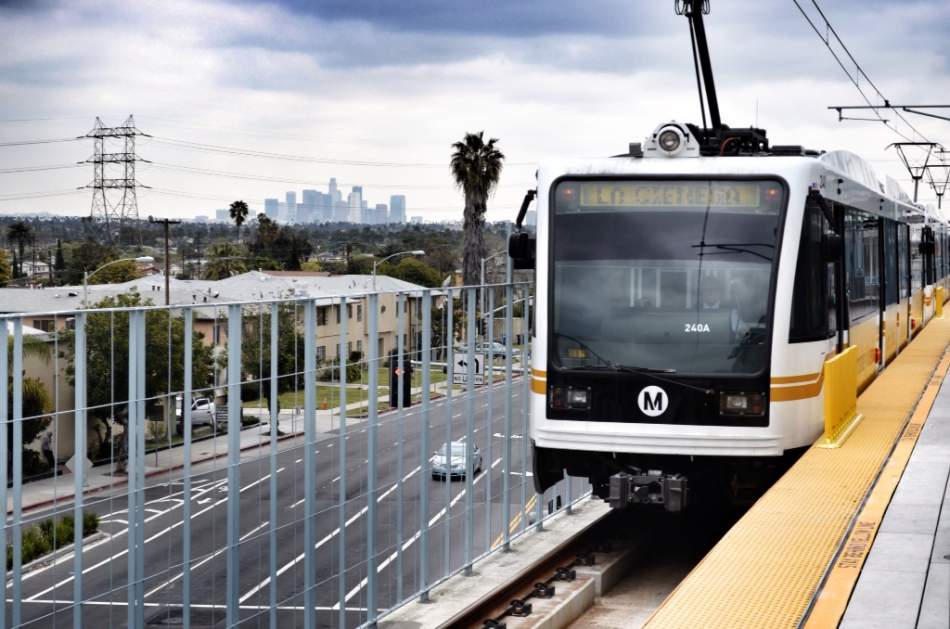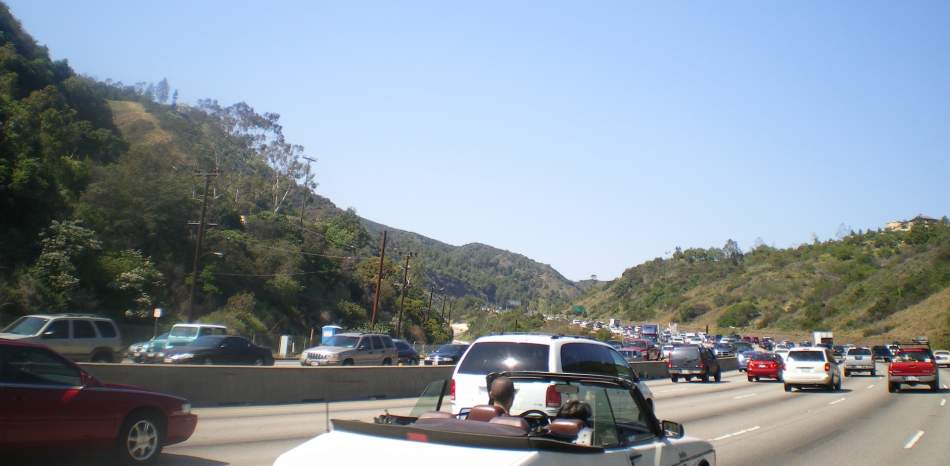Earlier this month, Metro released its initial concepts for a high-capacity transit line through the Sepulveda Pass, which would connect the Valley with the Westside. The agency is currently conducting a feasibility study for the corridor, and expects to complete its evaluation of the route across the Sepulveda Pass later this year and a connecting route from the Westside to LAX in 2019. With the 405 Freeway jammed despite repeated widening projects, there is clearly demand for a rail transit alternative running independently of car traffic. But are these truly our best options? Metro has laid out six workable alternatives, but there may be a cheaper option that avoids the construction of a costly tunnel beneath the Santa Monica Mountains.
Metro has presented six initial concepts. The first two are heavy rail lines going under Sepulveda Pass, one linking to Van Nuys Boulevard in the Valley and the other connecting to Sepulveda Boulevard. The next two are light rail lines to Van Nuys, one of which also includes a connection to a future post-light rail conversion Orange Line. The fifth uses unconventional modes such as monorail or rubber-tired metro, a technology used in Mexico City and on some metro lines in France. The sixth is a heavy rail line like the first concept, but instead branches off of the Purple Line.
The routes followed by all alternatives except the fifth are similar:
The entire route would be built as a tunnel on account of the steep grades of the Sepulveda Pass. On the south slope, the 405 has a grade of 3.1%, which is easily within the capabilities of urban rail. But on the north slope, the grade is 5.5%, which is more questionable. As a result, the only alternative that runs above ground is the monorail or rubber-tired metro, as both technologies have higher friction and are supposed to be capable of climbing steeper grades—and even that alternative has extensive tunneling. The real question is whether 5.5% grades are really too steep for conventional trains. They are certainly unusual, but unusual does not mean impossible.

Most modern subway and light rail trains have an initial acceleration rate of about 0.12 g, or 1.2 meters per second per second (or 2.7 miles per hour per second). This is an aggressive rate, designed around the needs of trains that make frequent stops within an urban area. Older trains had weaker motors and accelerated much more slowly than that. Mainline trains powered by diesel locomotives accelerate slowly as well: the locomotive has to pull a heavy train behind it and has trouble getting traction, whereas a subway or light rail train (or a modern regional train) has all motors powered, much like how a car with four-wheel drive has better performance than a car with two-wheel drive.
Since high acceleration rates are relatively recent, construction standards are still designed around the needs of older equipment. A train that accelerates at 0.12 g could theoretically climb grades up to 12%, but more realistically would need some margin of error to account for motor failures and slippery rails in wet weather. Fortunately, most modern urban rail equipment has each axle powered separately, providing extensive redundancy. Grades of 7% or even steeper should be possible.
The 7% figure is not just theoretical. This is the ruling grade on the Bernina Railway, a mountain railroad in Switzerland. The trains are conventional and do not require any assistance in climbing grades beyond their own electric motors. Closer to home, the Sacramento Light Rail has a grade separation over 19th Street with 7% grades.
Recognizing the grade-climbing abilities of modern light rail and subway trains, standards manuals allow for steep grades on urban rail lines. The Track Design Handbook for Light Rail Transit states,
The maximum allowable route grade is limited by the possibility that the LRV [light rail vehicle] could stall or the traction motors overheat. This is the steepest grade the LRV can negotiate. A short grade that the LRV enters at speed should not be a problem up to about 6%. Above that the operational requirements should be reviewed. Grades of up to 10% are possible. At grades between 6% and 10%, wheel-to-rail slippage may occur in poor conditions, such as when ice or wet leaves are on the rail. This may result in wheel flats during braking or rail burns during acceleration.
The American Public Transportation Association (APTA) makes similar recommendations:
While a maximum gradient of 5 percent is considered a desirable design criterion, there has been a need on some new systems to include track segments with gradients as steep as 7 and 8 percent. The cars operating on those systems negotiate these gradients without difficulty. LRT cars could be designed to climb a slope of 12 percent and indeed some predecessor streetcar lines had such gradients. However, 10 percent is now considered the limit from the perspective of passenger comfort. Exotic technologies with rubber tires or linear induction propulsion are not needed to conquer precipitous track profiles.
Either heavy or light rail could climb the Sepulveda Pass's 5.5% grades. Metro could build it along the alignment of the 405 without new tunneling, reducing costs substantially.
Of course it would not be free to build rail transit on the 405 even without a tunnel. The 405 is in a deep cut through the pass itself, and Metro would need to widen it, at a similar cost to that of adding a lane in each direction; the recent widening by just one lane in one direction cost $1.6 billion for ten miles after a budget overrun. Trains could go elevated over the roadway, but that would be even more expensive. They could cheaply take over highway lanes, which would be the best technical solution, but the politics of reducing the space available for cars on the 405 likely takes that option off the table. Nonetheless, compared with the per-mile cost of tunneling in Los Angeles such a budget would be a comparative bargain.
Following the 405 would introduce new questions about the alignment of the line. At the Valley end, the priority corridor is Van Nuys, but the 405 point toward Sepulveda Boulevard. Some additional elevated construction would be necessary to reach the desired corridor. While this would be somewhat circuitous for riders from Van Nuys, it would be faster for riders from Sepulveda, Balboa, and Reseda, the next three top north-south transit corridors in the Valley.
At the Westside end, the trains would need to be underground at UCLA to intersect the future Purple Line stop; the UCLA campus has no easy alignment for an above-ground north-south subway. Presumably they would transition to above-ground running farther south, depending on which of several north-south corridors on the Westside Metro chose to connect UCLA with LAX. Some options would have to remain underground for a long stretch, for example any stretch diverting east to connect to Century City. In contrast, Sepulveda Boulevard would be a good place for an elevated railroad, similar to those of New York or Chicago but built to be quieter, as the street is straight and wide enough that the visual impact of the viaduct wouldn't be onerous.
Sepulveda Pass is a choke point in Los Angeles's transportation network, and there are many different lines at both ends to connect it to, and several different options for how to cross it. However, to minimize cost, it's important for Metro to investigate options that stay above ground across the crest of the pass. Despite what the released alternatives imply, unconventional technology is not required; a conventional light rail vehicle could climb the Sepulveda Pass’s 5.5% grades, as could a conventional heavy rail subway train. As Metro decides how to spend a budget fixed by Measures M and R, it owes the people of the region the lowest-cost, highest-impact capital investments, to make sure the pot of money serves as many Angelenos as it can.
Alon grew up in Tel Aviv and Singapore. He has blogged at Pedestrian Observations since 2011, covering public transit, urbanism, and development. Now based in Paris, he writes for a variety of publications, including New York YIMBY, Streetsblog, Voice of San Diego, Railway Gazette, the Bay City Beacon, the DC Policy Center, and Urbanize LA. You can find him on Twitter @alon_levy.








